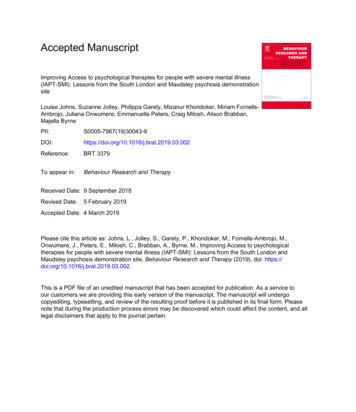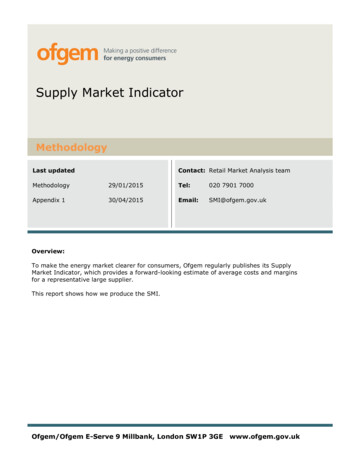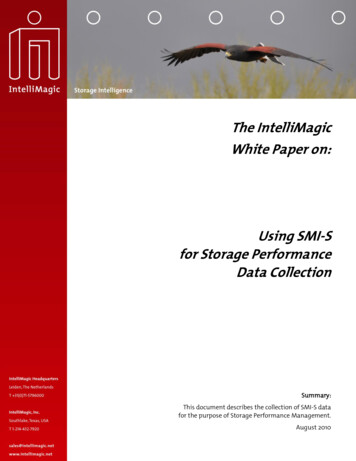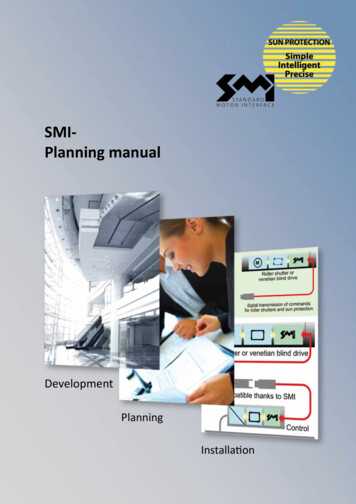
Transcription
Accepted ManuscriptImproving Access to psychological therapies for people with severe mental illness(IAPT-SMI): Lessons from the South London and Maudsley psychosis demonstrationsiteLouise Johns, Suzanne Jolley, Philippa Garety, Mizanur Khondoker, Miriam FornellsAmbrojo, Juliana Onwumere, Emmanuelle Peters, Craig Milosh, Alison Brabban,Majella 10.1016/j.brat.2019.03.002Reference:BRT 3379To appear in:Behaviour Research and TherapyReceived Date: 9 September 2018Revised Date:5 February 2019Accepted Date: 4 March 2019Please cite this article as: Johns, L., Jolley, S., Garety, P., Khondoker, M., Fornells-Ambrojo, M.,Onwumere, J., Peters, E., Milosh, C., Brabban, A., Byrne, M., Improving Access to psychologicaltherapies for people with severe mental illness (IAPT-SMI): Lessons from the South London andMaudsley psychosis demonstration site, Behaviour Research and Therapy (2019), doi: https://doi.org/10.1016/j.brat.2019.03.002.This is a PDF file of an unedited manuscript that has been accepted for publication. As a service toour customers we are providing this early version of the manuscript. The manuscript will undergocopyediting, typesetting, and review of the resulting proof before it is published in its final form. Pleasenote that during the production process errors may be discovered which could affect the content, and alllegal disclaimers that apply to the journal pertain.
ACCEPTED MANUSCRIPTImproving Access to Psychological Therapies for people with Severe Mental Illness(IAPT-SMI): lessons from the South London and Maudsley psychosis demonstrationsite.RIPTLouise Johns1,6,7* and Suzanne Jolley1,2 (joint first authors), Philippa Garety1,5, MizanurKhondoker3, Miriam Fornells-Ambrojo1,2,4, Juliana Onwumere1, Emmanuelle Peters1,2,King’s College London, Department of Psychology, Institute of Psychiatry, Psychology &Neuroscience, London, UKMANU1SCCraig Milosh2, Alison Brabban8, Majella Byrne1,22South London and Maudsley NHS Foundation Trust, London, UK3University of East Anglia, Norwich Medical School, Norwich, UK4University College London, Department of Clinical, Educational and Health Psychology,5TEDLondon, UKNational Institute for Health Research (NIHR) Biomedical Research Centre for MentalHealth at South London and Maudsley NHS Foundation Trust (SLaM), UKUniversity of Oxford, Department of Psychiatry, Oxford, UK7Oxford Health NHS Foundation Trust, Oxford, UK8University of Durham, Durham, UKACCEP6*Corresponding author.Oxford Early Intervention in Psychosis Service, Warneford Hospital, Headington, Oxford.OX3 7JX.Tel: 44 (0)1865 902724; Fax: 44 (0) 1865 261736e-mail: louise.johns@psych.ox.ac.uk
ACCEPTED MANUSCRIPTAbstract (208 words)Implementation of evidence-based cognitive behavioural therapy for psychosis (CBTp)remains low in routine services. The United Kingdom Improving Access to PsychologicalTherapies for people with Severe Mental Illness (IAPT-SMI) initiative aimed to address thisRIPTissue. The project evaluated whether existing services could improve access to CBTp anddemonstrate effectiveness using a systematic approach to therapy provision and outcomemonitoring (in a similar way to the Improving Access to Psychological Therapies (IAPT)SCmodel for people with anxiety and depression).We report the clinical outcomes and key learning points from the South London andMANUMaudsley NHS Foundation Trust IAPT-SMI demonstration site for psychosis.Additional funding enabled increased therapist capacity within existing secondary carecommunity mental health services. Self-reported wellbeing and psychotic symptom outcomeswere assessed, alongside service use and social/occupational functioning.TEDAccepted referrals/year increased by 89% (2011/12: n 106/year; 2012-2015: n 200/year);90% engaged (attended 5 sessions) irrespective of ethnicity, age and gender. The assessmentprotocol proved feasible, and pre-post outcomes (n 280) showed clinical improvements andEPreduced service use, with medium effects.ACCWe conclude that, with appropriate service structure, investment allocated specifically forcompetent therapy provision leads to increased and effective delivery of CBTp. Ourframework is replicable in other settings and can inform the wider implementation ofpsychological therapies for psychosis.2
ACCEPTED MANUSCRIPTIntroductionPsychosis is a severe mental illness characterised by unusual beliefs (delusions) andexperiences (hallucinations and other anomalous perceptions), and changes in cognitive,emotional and social functioning. It is distressing and disabling for sufferers and theirRIPTfamilies, and exacts high societal cost (Andrew, Knapp, McCrone, Parsonage, &Trachtenberg, 2012). The National Institute for Health and Care Excellence (NICE) guidelinefor schizophrenia and psychosis recommends that CBTp is offered in conjunction withSCantipsychotic medication (National Institute for Health and Care Excellence, 2014).However, delivery in routine practice is low (Colling et al., 2017; The SchizophreniaMANUCommission, 2012), partly due to unclear treatment pathways and insufficient therapistcapacity (Ince, Haddock, & Tai, 2016), presenting a major implementation challenge. TheIAPT-SMI initiative aimed to build on the success of IAPT for people with common mentalillness (Clark et al., 2009; Clark, 2018) and flagship service provision (Peters et al., 2015) toTEDimprove access to NICE-recommended psychological therapies for people with severe mentalillness (SMI) (bipolar affective disorder, personality disorders, psychosis) (Department ofHealth, 2011). The South London and Maudsley NHS Foundation Trust (SLaM) psychosisEPdemonstration site set out to test whether access to CBTp could be improved andACCeffectiveness demonstrated with: (i) appropriate service structure, (ii) trained staff, and (iii)routine outcome monitoring.MethodImproving Access to Psychological Therapies for people with Severe Mental Illness (IAPTSMI)This initiative aimed to enhance delivery of psychological therapies within existing servicesusing a systematic IAPT approach to therapy provision and evaluation, and provided3
ACCEPTED MANUSCRIPTadditional financial resource for therapy and outcome monitoring. IAPT is an Englishprogramme that aims to increase the availability of NICE recommended, evidence-basedpsychological treatments. Key features of the IAPT model include: training therapists toagreed competence criteria, with close, expert clinical supervision; employing routineRIPToutcome monitoring; and offering easy access with a prescribed waiting time. The originalIAPT initiative provided treatment for adults with depression and anxiety disorders. Thistemplate was used to develop models of care for people with long term conditions, includingSCsevere mental illness. Six IAPT-SMI demonstration sites ran from 1/11/12 to 31/3/16. Theyexamined i) to what extent the outcomes of clinical trials could be reproduced within routineMANUservices; and ii) how treatment pathways supported the delivery of psychological therapiesfor these patients. Details of the methods have been reported previously (Jolley et al., 2015),and are outlined below.TEDService and ReferralsSLaM covers four London boroughs, with high rates of ethnic diversity, populationmovement, drug use, socio-economic deprivation, and psychosis incidence. SLaM servicesEPwere organised within Clinical Academic Groups (CAGs), and the Psychosis CAG had fourACCCare Pathways: Early Intervention (EI), Promoting Recovery (PR), Complex Care, and AcuteInpatient Care. The IAPT-SMI service operated in the EI and PR pathways, alongsideexisting psychological therapy provision in Early Intervention and the Community MentalHealth Teams (CMHTs), and was coordinated by a standalone psychological interventionsclinic for patients with psychosis (PICuP) (Peters et al., 2015). The PR pathway servedpeople with established psychotic disorders, and the EI pathway saw people with a firstepisode of psychosis. Psychological therapists in existing services worked sessionally inIAPT-SMI, together with four therapists funded as part of the demonstration site. The full4
ACCEPTED MANUSCRIPTtherapist complement was ten whole time equivalents. Patients gave written consent for theirmeasures to be used pseudonymously for service evaluation, approved by SLaM’s audit andevaluation committee (PSYCHLO-13-18).IAPT-SMI therapists saw patients with psychosis whose needs could be met within aRIPTpsychological therapy service (i.e. people who opted in to a talking intervention; could attendfairly reliably; and who did not present with very high levels of risk or chaotic behaviour).There were no other exclusion criteria, and patients were seen with interpreters whenSCrequired. Therapy was offered flexibly, with a focus on engagement. Offers were carefullyframed to avoid invalidating people who located their problems externally, for example, asMANU‘help to manage current difficulties with other people’, rather than ‘help with paranoia’.Referrals were accepted from primary and secondary care, with a self-referral option.Medical and social care needs were managed in the CMHT or primary care.TEDAssessmentReferrals were screened by senior clinical psychologists, and accepted referrals werecontacted by an assessor who was independent of therapy delivery (graduate psychologyEPassistant) to explain the service. Patients wishing to proceed (‘opting in’) were offered a 60-ACC90 minute pre-therapy assessment, and then therapists offered a first therapy appointmentwithin three to four weeks. Independent assessments were repeated at three-months, end oftherapy, and follow-up (mean 9.5 months, range 5-18m). A sessional measure was completedat every therapy appointment, with the therapist’s help if needed.TherapyCBTp is an adaptation of CBT for emotional disorders and draws on cognitive models ofpsychotic symptoms (Johns, Jolley, Keen, & Peters, 2014). It promotes an individualised5
ACCEPTED MANUSCRIPTformulation of the person’s psychosis, and intervenes with the psychological processes thatare maintaining distress and impeding recovery. Therapy is tailored to personal goals, and thetherapeutic relationship is genuinely collaborative and characterised by explicit warmth andtransparency (Brabban, Byrne, Longden, & Morrison, 2017). Therapy was offered to suit theRIPTperson’s needs, aiming for at least 16 one-hour sessions in line with NICE guidance. Sessionsoccurred weekly to fortnightly over six to nine months, usually in the referring team’s base ora central clinic. Therapy drew on a wide range of published manuals (e.g. Meaden, Keen,SCAston, Barton, & Bucci, 2013; Anthony P. Morrison, 2002 [listed in Johns et al., 2014];Anthony P. Morrison, 2017) and was adherent to the IAPT-SMI CBTp competenceMANUframework (Roth & Pilling, 2013). IAPT-SMI therapists were trained to competence, usingstandardised assessments of therapy skills (Fowler, Rollinson, & French, 2011). Training wasusually 12-24 months of post-qualification, postgraduate study (Jolley et al., 2012),comprising 226 hours of teaching and supervision, 476 hours of clinical work, and 300 hoursTEDof assignment work. Within IAPT-SMI, group clinical supervision was provided weekly tofortnightly, with additional fortnightly to monthly individual supervision. This equated toapproximately 0.7 supervisor hours per therapist per week for ongoing supervision.EPSupervisors were senior clinicians with 10-20 years of experience of training therapists andACCof providing CBTp within NHS services and randomised controlled trials.MeasuresIAPT-SMI implemented routine outcome monitoring across the service, including activity(referrals, waiting times), performance (outcomes, service use), user experience andsatisfaction. The IAPT-SMI outcomes battery comprised the four measures described below,together with patient experience questionnaires and the Euroqol group’s EQ5D (The EuroQolGroup, 1990) measure of Quality of Life, both of which are reported separately. We6
ACCEPTED MANUSCRIPTadditionally report outcomes on the self-report Clinical Outcomes in Routine Evaluation-10(CORE-10) (Barkham et al., 2012), which generates a mean total distress score based on tenitems, each rated from 0 to 4, ranging from 0 (healthy) to 40 (severe). A change of 5 points ormore is considered reliable. Functional outcome was rated using IAPT criteria of engaged inRIPTmeaningful activity (in a work, domestic, voluntary or academic setting) or unoccupied.Demographic, activity, and service use data were collected by self-report and from theelectronic health record. Service use data comprised duration of mental health admissionsSC(occupied bed days, OBDs) and number of days under a crisis team (crisis team days, CTDs),calculated as a mean/person/month. Self-reported ethnicity was dichotomised into Black andIAPT-SMI clinical outcomesMANUMinority Ethnic (BME) or other group (non-BME).1. Choice of outcome in cognitive therapy for psychoses (CHOICE) (Greenwood et al., 2010):TEDAn 11-item version of this self-report measure was completed sessionally. Each item is ratedfrom 0 (worst) to 10 (best), giving a mean total score ranging from 0 to 10. The CHOICE wasdetermined a priori as the primary outcome measure for the psychosis demonstration sites,EPand reliable improvement / deterioration predetermined as a change of 1.45 in mean totalACCscore. The 11-item version was based on the highest loading items from the 34-item measure,and it has good reliability and validity.2. Warwick-Edinburgh Mental Wellbeing Scale (WEMWBS) (Tennant et al., 2007): Fourteenitems on this self-report measure are rated from 1 (none of the time) to 5 (all of the time),yielding a total score ranging from 14 to 70. Sensitivity analyses suggest a change of 3 torepresent meaningful clinical change (Maheswaran, Weich, Powell, & Stewart-Brown, 2012).7
ACCEPTED MANUSCRIPT3. Work and Social Adjustment Scale (WSAS) (Mundt, Marks, Shear, & Greist, 2002): Fiveself-report items rate functional impairment from 0 (low) to 8 (very severe), yielding a totalscore from 0-40. A reduction of 13 points is considered to represent reliable change.4. Psychotic Symptom Rating Scales (PSYRATS) (Haddock, McCarron, Tarrier, & Faragher,RIPT1999): This practitioner-administered structured interview of voices (11 items) and delusions(6 items) is completed with individuals with a recent history of the relevant symptom (duringthe past month), and each item is rated for increasing severity from 0 to 4. Voices (0-44) andSCdelusions (0-24) scores are reported separately (PSYRATS-V and PSYRATS-D).MANUAnalysesThe data were analysed using SPSS (version 22) and STATA (version 12). Outcomes arereported for therapy engagers (attended 5 sessions) from the start of the service on 01/11/12to the final reporting date of 31/03/16. Therapy dropout was defined a priori as attendingTEDfewer than five sessions, which was considered too few to receive a meaningful ‘dose’ oftherapy (7). Therapy engagers did not differ significantly from dropouts on gender, ethnicity,care pathway or diagnosis; there was a near-significant effect for age, and dropouts tended toEPbe younger (see Table 1). Primary clinical outcome (CHOICE) and service use (OBDs,ACCCTDs) data were collected for all engagers; functioning and secondary clinical outcomes(CORE-10, WEMWBS, WSAS, PSYRATS) were collected for those attending anassessment session.Clinical outcome data were analysed by an independent statistician (MK) using linearmixed model analyses including all available data at each time point. Missing data can lead tobiased estimates of the treatment effect. A recommended way to reduce potential bias is toanalyse all the observed outcome data using a mixed model via the maximum likelihoodmethod under a plausible missing data mechanism such as the missing at random mechanism8
ACCEPTED MANUSCRIPT(White, Horton, Carpenter, & Pocock, 2011). We included demographic variables of age,gender and ethnicity as covariates in all models to assess any potential impact of these factorson outcomes. We also controlled for predictors of missing data in outcomes. To investigatepotential predictors, we created a binary indicator (0 no missing data, 1 at least one of fourRIPTassessments missing) of missing data for each outcome and screened for predictors ofmissing data using a series of logistic regression analyses. Covariates that were statisticallysignificant at the 5% level in the logistic models (reported below in Results) were controlledSCfor in the respective analyses of the outcome data to minimise potential bias arising frommissing data. The analyses of primary and secondary outcomes were performed using linearMANUmixed effects models to take account of the longitudinal (clustered) nature of the data.Random effects for clinical team (EI, CMHT, PICuP) and participant were tested; the formerwas not significant and was dropped from the analyses. The effectiveness of CBTp was testedby comparing pre-therapy with mid-therapy (3 month assessment), post-therapy (end ofTEDtherapy assessment or last sessional CHOICE), and follow-up (where available).Comparisons between mid- and post-therapy and between post-therapy and follow-up werealso tested using Stata’s ‘lincom’ command following the estimation of the linear mixedEPmodels. Effect sizes (ES) were calculated using the user contributed Stata command ‘cohend’ACC(Tannenbaum, 2011), and we report Cohen’s d corrected for uneven groups (due to missingdata at the different time points). All outcome data were analysed, followed by subsetanalysis by care pathway (EI or PR) using a Time x Pathway interaction.Wilcoxon matched-pair signed-rank tests and the McNemar test were used to assessthe significance of change in service use (OBDs, CTDs) and functional outcome,respectively, over the course of therapy. Within-participant effect sizes (ES, Cohen’s d) werecalculated using the pooled standard deviation to minimise inflation of effects.9
ACCEPTED MANUSCRIPTResultsReferrals and therapy completionOn the final day of reporting (31/10/15), there were 5602 people with psychosis being treatedin the PR pathway and 767 in the EI pathway. During the referral period (1/11/12 - 31/10/15),RIPT703 people were referred for CBTp within IAPT-SMI, and 599 (85%) were accepted asappropriate referrals. Accepted referrals of 200/year over 2012-2015 compared with 106 inthe year before IAPT-SMI, an increase of 89%. Eight-six percent (514/599) of acceptedSCreferrals opted in, 89% (456/514) of these attended their assessment, and 88% (402/456) ofthese had started therapy by the end of the referral period (67% of the original 599 acceptedMANUreferrals). Those who were not offered therapy opted out after the assessment (n 39) or werereferred to or given details of an alternative, more suitable service (n 15). Referrals andattrition are shown in Figure 1. Mean time from referral to assessment was 37 days (SD27.7), and from assessment to first therapy session was 64 days (SD 57). These waitingTEDtimes include time to arrange appointments and accommodation of patient preferences andcancellations. By 31/03/16, 342 cases had completed their involvement with IAPT-SMI: 303engagers (75% of those starting); and 39 (9.7%) who dropped out (received 5 sessions).EPFifty-eight were either still in therapy (n 48) or had not completed for other reasons (n 10).ACCTherapy engagers attended, on average, 18 sessions (SD 8.1) over 8 months (SD 4). A fulltime therapist completed therapy with 20 patients per year, with a caseload of 15 patients atany one time and weekly therapy sessions. Demographic data, care pathways, and diagnosesof completed cases are shown in Table 1.Figure 1 and Table 1 herePrimary clinical outcome (CHOICE) (Table 2)10
ACCEPTED MANUSCRIPTThe paired completion rate (first-last CHOICE over the course of therapy) was 93% (n 280).Predictors of missing CHOICE data were diagnosis and pre-therapy WSAS and WEMWBS(higher WSAS and WEMWBS scores, and ‘other’ diagnosis predicted fewer missing data).These covariates were controlled for in the analysis to minimise any potential bias. TherapyRIPTengagers improved during therapy, with increased post-therapy (or last sessional) scores(ES 0.7), which were maintained at follow-up (ES 0.5). There were no significantdifferences between EI and PR for any of the comparisons, and no effects of the demographicSCcovariates on outcomes. Forty nine percent of therapy completers showed reliableimprovement on the CHOICE (mean score increased by 1.45). Fourteen (5%) showedteam referral.MANUreliable deterioration (mean score reduced by 1.45), but none required admission or crisisTable 2 hereTEDSecondary clinical outcomes (Table 3)Missing data predictors were: diagnosis and pre-therapy employment status for WEMWBS;diagnosis, pre-therapy employment status and WEMWBS scores for WSAS; and diagnosisEPfor PSYRATS-V. Higher WEMWBS scores, not engaged in meaningful activity, and ‘other’ACCdiagnosis predicted fewer missing data. These were controlled for in the respective analysesto reduce any potential bias arising from missing data. Paired completion rates on themeasures (pre-post therapy) ranged from 80-86%. Baseline scores indicated moderate levelsof distress and functional impairment, and low subjective wellbeing. Sixty percent of patientsreported current positive psychotic symptoms (voices and/or delusions). There weresignificant improvements on all measures during therapy (ES 0.45-1.00), most of whichwere maintained at follow-up (ES 0.3-0.75). Therapy engagers reported reduced levels ofdistress, greater subjective wellbeing, improved functioning, and reduced severity of voices11
ACCEPTED MANUSCRIPTand delusions. There was a significant pathway difference only for PSYRATS-V scores(Time x Pathway interaction p 0.015): the improvement was greater in the EI group posttherapy, and the improvement within the PR group was not maintained in the follow-upTable 3 hereService useRIPTsample.SCPaired service use data were available for all therapy engagers. Average use/person/month inthe year preceding therapy was 0.8 occupied bed days (OBDs) (SD 2.2, range 0-14) and 0.5MANUcrisis team days (CTDs) (SD 1.5, range 0-15), which reduced to 0.2 OBDs (SD 1.2, range0-12) and 0.1 CTDs (SD 0.5, range 0-5) during therapy (Wilcoxon matched-pair signed-ranktest, p 0.001; OBDs: d 0.45; CTDs: d 0.4).TEDFunctioning outcomesPaired outcomes were available for 89% of therapy engagers (n 269). Improvement (fromunoccupied to meaningful activity) was reported by 18.5% (n 50), no change for 74.5%EP(n 200), and a reduction in activity (from meaningful to unoccupied) for 7% (n 19). ThereACCwas a significant change in the proportion of patients engaged in meaningful activity beforeand after therapy, with a net change of 31 patients from unoccupied to activity (relatedsamples McNemar test, p 0.001).DiscussionCBTp is recommended by clinical guidelines, but delivery in routine services is low. Thedemonstration site showed that it is possible to enhance delivery of NICE-concordant CBTpin routine secondary care services using a systematic approach, and to demonstrate12
ACCEPTED MANUSCRIPTeffectiveness with routine outcome monitoring. The large number of patients who werereferred and who opted-in showed that demand for CBTp is high. Three main factorsfacilitated increased access (Jolley et al., 2015). Firstly, SLaM Trust was organisationallyready to be a demonstration site, with strong clinical leadership and a critical mass of staffRIPTtrained to deliver and supervise CBTp to a high standard. Secondly, funding was ring-fenced(i.e. restricted for IAPT-SMI use) and could be translated almost immediately into increaseddelivery by the creation of dedicated psychological therapist posts. With regard to treatmentSCpathways, therapy provision was embedded in the team within Early Intervention, facilitatingengagement with patients. In Promoting Recovery, IAPT-SMI provided a separate-but-linkedMANUpsychology service (people who were ambivalent about therapy, or engaged erratically, wereoffered psychological therapy within their Community Mental Health Team). Thirdly, thespecialised focus of the service meant that all staff understood the difficulties facing peoplewith psychosis, and how to accommodate these to engage clients in therapy. The findings areTEDconsistent with previous reports (Ince et al., 2016) that a lack of skilled therapist capacity andappropriate service structure contribute to poor implementation, rather than a lack of demandfor CBTp. The large number of patients with psychosis in the treatment pathways highlightsACCcaseload.EPthe size of the need and, despite its success, IAPT-SMI still only saw a percentage of the totalThe site demonstrated effectiveness of CBTp using routine outcome monitoring.Changes on the primary outcome measure compare favourably with those in IAPT servicesfor people with Common Mental Illness, with medium to large pre-post effect sizes (Clark etal., 2009; Gyani, Shafran, Layard, & Clark, 2013). Pre-post changes on secondary measuresand the effect sizes are comparable to other effectiveness studies of CBTp in clinical services(Lincoln et al., 2012; A. P. Morrison et al., 2004; Peters et al., 2015). In addition, reductionsin service use during therapy, together with improvement in meaningful activity, suggest13
ACCEPTED MANUSCRIPTpotential for cost-effective delivery. Our results provide further evidence that it is possible toreproduce the therapy outcomes of clinical trials within routine services. In particular, the sitedelivered CBTp and achieved good outcomes at scale across an IAPT-SMI service thatincluded community teams in addition to a specialised psychological therapies service. TheRIPTpatients were symptomatic, presenting with psychotic symptoms and/or emotional problemsof moderate severity. Our patient group had rates of ethnic variation similar to those of ourcatchment areas, and we found no significant demographic inequity in therapy engagement orSCprimary outcome.Routine outcome monitoring was feasible and acceptable to patients. AssistantMANUpsychologists conducted pre, mid- and post-therapy assessments, which reduced the burdenon therapists. The initial assessment also served as a cost-effective triage system, reducingtherapist time spent chasing referrals who eventually opted-out. Rates of attendance at posttherapy assessments were good for engagers (80%), showing that patients are willing toTEDcomplete assessments. The sessional measurement achieved the high rates of paired outcomesobtained in IAPT-CMI ( 90%). Patients mostly found outcome monitoring satisfactory(Fornells-Ambrojo et al., 2017), and sharing this information helped to allay therapists’ACCEPreservations about sessional measurement.LimitationsThe primary limitations of the evaluation are its site-specificity and the uncontrolled design.Assessments were independent of therapy but not blind, and the primary outcome measurewas novel. Reported effects are within-participant and pre-post, so we cannot infer thatchanges definitely occurred as a result of therapy, although findings from the PICuP serviceusing a similar design have shown no changes during a waiting list period (Peters et al.,2015). The within-participant effect sizes cannot be compared directly with the smaller14
ACCEPTED MANUSCRIPTbetween-group or meta-analytic effect sizes for CBTp, which range from 0.2 to 0.4. Followup assessments were only implemented across the service 18-months into the pilot, and therewas loss to follow-up, especially in the Early Intervention group. Hence, we cannot assumethat the maintenance of therapy gains in the follow-up sample would generalise to the rest ofRIPTthe patient group.ImplicationsSCThe challenge within the NHS is to deliver, at scale, evidence-based therapies that reproducethe outcomes achieved in therapy trials. This IAPT-SMI demonstration site demonstrated thatMANUa systematic approach, whereby psychological therapies are prioritised and evaluated, canoperate effectively in routine community services, within or alongside the CMHT, and canproduce good clinical outcomes. Our experience shows that once referral pathways andexpert supervision structures are established, the recruitment of well-trained, or trainable,TEDtherapists into specialist posts will result in increased and potentially cost-effective delivery.The UK Early Intervention in Psychosis Access and Waiting Time Standard (NHSEngland, the National Collaborating Centre for Mental Health, & National Institute forEPHealth and Care Excellence, 2016) has facilitated access to CBTp within EI teams throughACCadditional funding for posts and training. However, there remains a need to support dedicatedtherapy posts in teams, and to ensure that therapists who complete CBTp training have thetime to deliver therapy. Previous attempts to train up case managers have had limited success,due to lack of protected time (Brooker & Brabban, 2004), and widening access topsychological therapies requires roles that are dedicated, at least in part, to therapy delivery(Garety et al., 2018). Our findings can inform the work of NHS England to meet thecommitments set out in the Five Year Forward View for Mental Health (NHS England, 2016)to improve access to NICE-recommended psychological therapies for people with severe15
ACCEPTED MANUSCRIPTmental illness. The IAPT-SMI approach is also compatible with the Coordinated SpecialtyCare (CSC) model for first episode psychosis in the US (Heinssen, Goldstein, & Azrin,2014), and offers a framework for therapy provision and evaluation within the CSC program.efficient and effective therapy delivery (Jolley, 2018).Conclusion:RIPTWith the key facilitators of implementation in place, new investment translates readily intoSCThe SLaM IAPT-SMI demonstration site showed that NICE-recommended i
1King's College London, Department of Psychology, Institute of Psychiatry, Psychology & Neuroscience, London, UK 2South London and Maudsley NHS Foundation Trust, London, UK 3University of East Anglia, Norwich Medical School, Norwich, UK 4 University College London, Department of . (CAGs), and the Psychosis CAG had four Care Pathways: Early .










